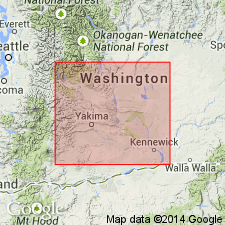
- Usage in publication:
-
- Sand Hollow flow
- Modifications:
-
- Original reference
- Dominant lithology:
-
- Basalt
- AAPG geologic province:
-
- Eastern Columbia basin
Summary:
Pg. 8, 13-17. Sand Hollow flow of Frenchman Springs Basalt Member of Yakima Basalt. Flow in middle part of Frenchman Springs Basalt Member (new). Above Gingko flow (new) and below Sentinel Gap flow (new). In some areas underlies Roza Basalt Member (new). Field term for unit, "double-barreled" flow expresses jointing habit that is its distinctive feature; in cliff exposures on east side of Columbia Valley north and south of Sand Hollow the colonade, consisting of regular prismatic columns 4 to 6 feet in diameter and 20 to 30 feet in height, is almost exactly matched by columnar zone 30 to 40 feet thick near top of flow. The entabulature, consisting of one or more tiers of small columns, is about 30 feet thick. Age is Miocene.
Named from occurrence in Sand Hollow [on east bank of Columbia River, in secs. 26, 27, and 28, T. 17 N., R. 23 E., Vantage 7.5-min quadrangle, Grant Co.], between Vantage and Priest Rapids, central southern WA.
Source: Publication; US geologic names lexicon (USGS Bull. 1350, p. 662).
For more information, please contact Nancy Stamm, Geologic Names Committee Secretary.
Asterisk (*) indicates published by U.S. Geological Survey authors.
"No current usage" (†) implies that a name has been abandoned or has fallen into disuse. Former usage and, if known, replacement name given in parentheses ( ).
Slash (/) indicates name conflicts with nomenclatural guidelines (CSN, 1933; ACSN, 1961, 1970; NACSN, 1983, 2005, 2021). May be explained within brackets ([ ]).

